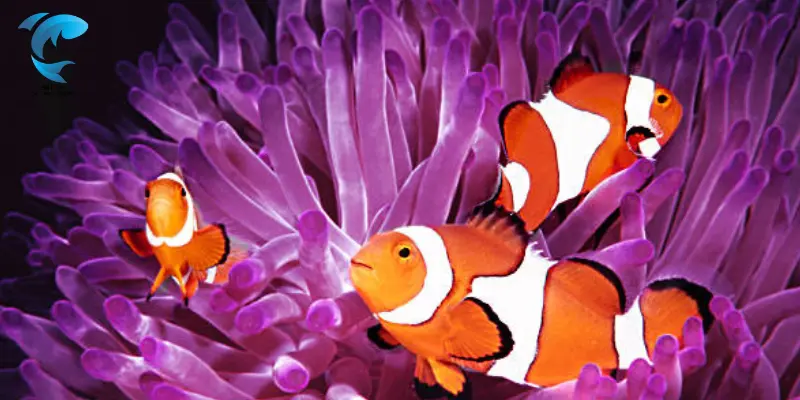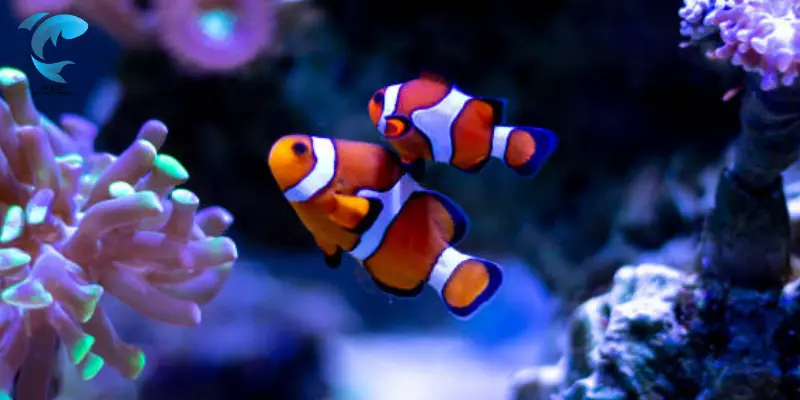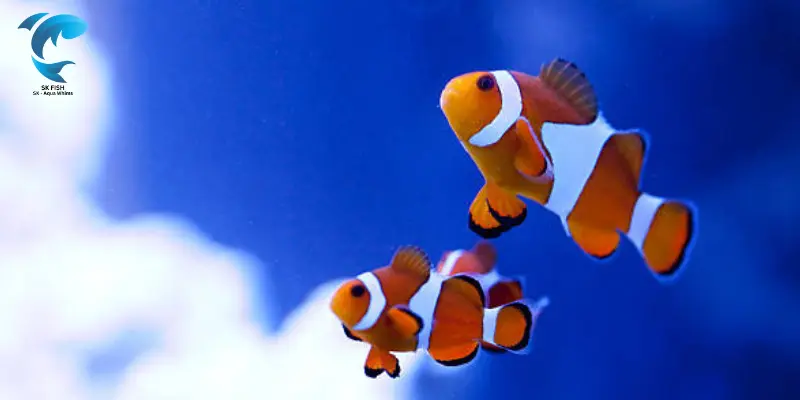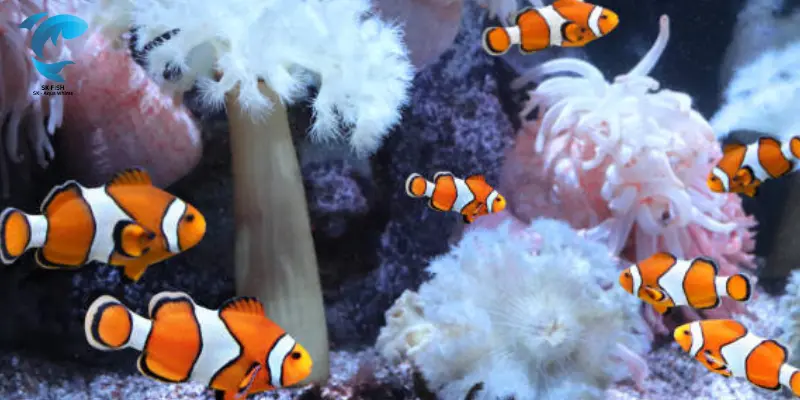Ocellaris Clownfish Care Guide: Top Tips for 2025
Published: 9 Mar 2025
Many aquarium owners struggle to keep Ocellaris clownfish healthy and thriving in their tanks. Poor water conditions, incompatible tank mates, or an inadequate diet can lead to stress, disease, and even premature death. Without the proper care, your clownfish might not live up to their potential.
In this guide, we’ll cover everything you need to know to ensure your Ocellaris clownfish flourish in a balanced, vibrant environment.
1. Physical Characteristics and Identification
Ocellaris clownfish, with their iconic orange and white stripes and distinctive black outlines, are easily recognizable. These fish, known for their round, bulbous faces, can grow up to about 3 inches (7.5 cm) in length.
Gender Differences
In the wild, the more prominent female Ocellaris clownfish dominates, with the smaller male occupying a secondary role. In captivity, however, these gender roles can often be observed when two clownfish are paired in a tank.
Varieties and Color Morphs
While the traditional orange-and-white Ocellaris clownfish is most commonly seen, breeders have developed several color morphs, including black-and-white versions. These color variations are popular with hobbyists looking to add unique aesthetics to their reef tanks.

2. Habitat and Natural Distribution
Ocellaris clownfish are native to the warm waters of the Pacific Ocean, particularly around the coasts of Southeast Asia, northern Australia, and the Philippines. In the wild, they live in shallow coral reefs and form a symbiotic relationship with sea anemones.
Water Conditions in the Wild
- Temperature: 74°F – 80°F (23°C – 27°C)
- pH: 7.8 to 8.4
- Salinity: 1.023 to 1.025 SG (Specific Gravity)
These fish prefer calm waters with low to moderate water flow, which helps mimic the conditions found in their natural habitat.
3. Behavior and Social Structure
Ocellaris clownfish are social creatures known for their strong territorial instincts. They live in groups within their anemone homes, protecting their territory and defending against potential threats.
Symbiotic Relationship with Sea Anemones
One of the most fascinating aspects of Ocellaris clownfish is their mutualistic relationship with sea anemones. The clownfish are immune to the venom of the anemone’s tentacles, which would typically sting other fish. In return, the clownfish offers the anemone food (like small crustaceans) and protection from predators.
4. Ocellaris Clownfish Diet
Ocellaris clownfish feed on zooplankton, small crustaceans, and algae in the wild. However, they can be fed various foods in an aquarium to ensure a well-rounded diet.
Best Foods for Ocellaris Clownfish
- Flake foods designed for carnivorous fish
- Frozen or live brine shrimp
- Mysis shrimp
- Algae-based foods (e.g., nori)
Feeding Tips: Feed your clownfish 2-3 times daily in small amounts to ensure food does not pollute the water. A varied diet will help maintain their bright colors and overall health.

5. Aquarium Care: How to Keep Ocellaris Clownfish Happy and Healthy
Tank Setup
Ocellaris clownfish are relatively easy to care for, making them an excellent choice for beginner hobbyists. However, providing the right environment is essential for their well-being.
Tank Size
The minimum recommended tank size for one Ocellaris clownfish is 20 gallons, but a 30-gallon tank is ideal for a pair.
Water Conditions
Keep the water temperature between 74°F – 80°F (23°C – 27°C), salinity at 1.023 to 1.025 SG, and pH between 7.8 and 8.4.
Filtration
A sound filtration system is crucial for maintaining water quality. Consider using a protein skimmer and an efficient filter.
Tank Mates
Ocellaris clownfish are generally peaceful and can be kept with other non-aggressive fish. They can live alongside peaceful reef fish, such as gobies, tangles, and wrasses.
Water Flow
Moderate water movement is ideal, simulating the reef environment where Ocellaris clownfish thrive. Let’s dive into the Fascinating and charming habitat and distribution of Clownfish.
6. Breeding Ocellaris Clownfish
Breeding Ocellaris clownfish in an aquarium is a straightforward process, making them a favorite among hobbyists who wish to breed fish. These fish are monogamous, forming pairs that mate for life.
Breeding Behavior
- Female clownfish lay their eggs on a flat surface near the anemone, often on a rock or coral.
- The male guards the eggs and keeps them clean. Once the eggs hatch (usually after 6-10 days), the fry is ready to swim and search for food.
Caring for Fry
Once the eggs hatch, the fry will require special care, including live food such as rotifers and newly hatched brine shrimp. It’s essential to keep them in a separate tank to avoid predation from adult fish.
7. Common Health Issues and How to Prevent Them
Like all aquarium fish, Ocellaris clownfish can fall victim to specific health issues. The most common diseases include:
- Ich (White Spot Disease): Caused by a parasitic infection, this is characterized by white spots on the fish’s body.
- Fin Rot: This condition occurs when the fins deteriorate due to poor water quality.
- Skin Lesions: These can develop from bacterial infections or injury.
| Prevention Tips |
|---|
|

8. The Importance of Symbiosis: Clownfish and Sea Anemones
One of the most captivating aspects of Ocellaris clownfish is their mutualistic relationship with sea anemones. The clownfish’s mucus-covered skin protects them from the anemone’s stinging cells, while the clownfish provides food for the anemone and helps defend it from predators.
| Best Anemones for Clownfish |
|---|
|
9. Fun Facts and Myths About Ocellaris Clownfish
| Fun Facts |
|---|
|
Myths
| Myth: Ocellaris clownfish are aggressive and brutal to keep |
|---|
Debunked: Ocellaris clownfish are not aggressive. They are peaceful, especially when given enough space and compatible tank mates. As long as you provide a designated territory, they thrive in community tanks. |
| Ocellaris clownfish must have a sea anemone to survive |
|---|
Debunked: While clownfish love anemones, they don’t need them to survive. They can thrive without one, adapting to tanks without anemones as long as their environment is suitable. |
| Ocellaris clownfish are the same as accurate clownfish |
|---|
Debunked: Ocellaris and true clownfish (Amphiprion percula) are related but different species. Ocellaris clownfish are larger, more adaptable, and easier to keep than true clownfish, which are more sensitive. |
| Myth: Ocellaris clownfish will always live with a sea anemone |
|---|
Debunked: Not all clownfish live with anemones, even in the wild. While they enjoy an anemone’s protection, they can live happily without one in an aquarium. |

Key Takeaways: Ocellaris Clownfish Care Guide
- Ideal Tank Setup: Ocellaris clownfish thrive in a 20-30 gallon tank with stable water conditions (74°F-80°F temperature, pH 7.8-8.4, salinity 1.023-1.025). A sound filtration system and moderate water flow are essential.
- Feeding Needs: Offer a varied diet, including flake, brine shrimp, and algae-based foods. Feed 2-3 times daily in small portions to maintain their health and vibrant color.
- Tank Mates: These peaceful fish can live with other non-aggressive species like gobies and wrasses. Ensure ample space to allow territorial behavior.
- Breeding Tips: Ocellaris clownfish are monogamous and breed readily in captivity. They lay eggs on flat surfaces, and the male guards them until they hatch, requiring separate care for the fry.
- Health Management: Regular water changes and monitoring parameters prevent common health issues like Ich and fin rot. Stress signs include faded color and loss of appetite, often due to poor water quality or incompatible tank mates.
Conclusion: Why Ocellaris Clownfish Are the Ideal Aquarium Pet
Ocellaris clownfish are one of the best choices for beginner aquarium enthusiasts. Their vibrant appearance, fascinating behavior, and ease of care make them a rewarding addition to any tank. Whether you’re interested in keeping them with a sea anemone or enjoying their peaceful nature in a reef setup, Ocellaris clownfish offers something special for any aquarium.
Ready to add a clownfish to your tank? Browse our selection of clownfish supplies and equipment to get started!
Frequently Asked Questions
Ocellaris clownfish are social but territorial fish. Typically, a pair will form a strong bond, and you can keep two in a tank without issues. If you want to keep more than two, providing a larger tank and ensuring the space allows them to establish territories is essential. A 30-gallon tank or larger is recommended for a pair.
Yes, Ocellaris clownfish can live without a sea anemone. While they have a natural symbiotic relationship with anemones in the wild, they do not depend on them for tank survival. Many hobbyists successfully keep clownfish in aquariums without anemones.
Ocellaris clownfish are adaptable but require stable water conditions to stay healthy. The ideal temperature is between 74°F and 80°F (23°C – 27°C), with a pH level between 7.8 and 8.4. Salinity should range from 1.023 to 1.025 SG.
Ocellaris clownfish are peaceful and can live with various other reef-friendly fish. They are best kept with non-aggressive species like gobies, wrasses, and tangs.
Stress can manifest in several ways in Ocellaris clownfish, such as faded color, erratic swimming, hiding, or loss of appetite. Stress is often caused by poor water quality or incompatible tank mates.

SK Fish is your trusted source for practical fish care tips and delicious seafood recipes. Our team is dedicated to providing reliable, well-researched content for fishing enthusiasts and home cooks alike.

- Be Respectful
- Stay Relevant
- Stay Positive
- True Feedback
- Encourage Discussion
- Avoid Spamming
- No Fake News
- Don't Copy-Paste
- No Personal Attacks



- Be Respectful
- Stay Relevant
- Stay Positive
- True Feedback
- Encourage Discussion
- Avoid Spamming
- No Fake News
- Don't Copy-Paste
- No Personal Attacks





